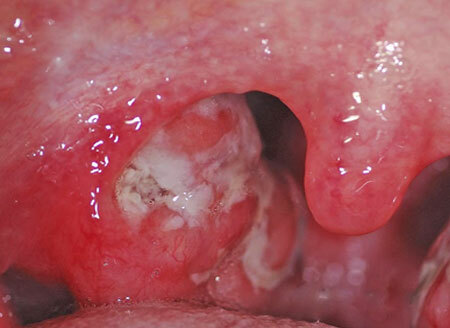Sore throat and inability to swallow are the most common symptoms of sore throat. At the initial stage of the development of the disease, these symptoms are typical for all types of angina.
The term "angina" refers to the inflammation of the tonsils. The classification of pathology is very extensive, as it is distinguished by many factors causing the disease, as well as the diversity of forms and species.
Catarrhal angina is one of the easiest forms of inflammation of the tonsils, the inflammatory reaction affects only the mucous layer, not penetrating deeper. This may be the first stage of more severe forms of sore throat, for example, lacunar or follicular.
Therefore, ignore the disease is not worth it. At the first signs of inflammation in the tonsils should consult a doctor for the appointment of treatment.
In the international classification of diseases( ICD-10) the diagnosis of "catarrhal sinusitis" can not be met, since all forms of angina experts have been combined. Any acute inflammation of the tonsils in ICD-10 is combined into one code J03.0, which has a common name - acute tonsillitis.
The causes of catarrhal

The first signs are perspiration and sore throat, photo
Angina is a disease of an infectious nature with an allergic component. Most often caused by streptococci and staphylococci. It is possible that inflammation develops in the tonsils of the tonsils and fungi and viruses.
The catarrhal form of angina is more often observed in the off-season, when immunity is weakened, and changeable weather promotes hypothermia.
The disease can be transmitted from a sick person to a healthy person, so there are outbreaks in places where a large number of people daily contact( kindergartens, schools, offices, etc.).
Contents
- 1 Symptoms of catarrhal sore throat photo
- 2 Methods for treatment of catarrhal
- 3 Complications of catarrhal
Symptoms of catarrhal sinus, photo of throat
The appearance of the first symptoms occurs 2-3 days after infection, sometimes only a few hours. Everything depends on the state of immunity and reactivity of the organism.
Symptoms are divided into general and local. Common signs include the following:
- Increased body temperature. Values can range from 37.5 to 39 degrees. The disease can also occur without temperature.
- Symptoms that indicate the intoxication of the body with microbial toxins: weakness, headache and muscle pain, lack of appetite, a sharp decline in performance.

Photo of the throat in catarrhal
Signs of local angina:
- Pershing and sore throat.
- Inability to swallow food, liquids and saliva.
- When examining the throat, the doctor ascertains an increase in tonsils in size, their redness. The tonsils are covered with a cloudy coating, in a white tongue of plaque. There is no pus on the tonsils.
- When probing nearby lymph nodes( submandibular), tenderness is noted, the nodes themselves are enlarged in size.
Methods of treatment of catarrhal sinitis

Although catarrhal angina is considered to be the mildest form and the disease affects only the surface layer of the tonsils, treatment should not be neglected.
The infectious agent should be rendered harmless and removed from the body, otherwise complications may develop and the transition to the chronic stage.
Principles of treatment of the disease are based on the use of antibacterial drugs, as the disease is contagious, compliance with special treatment and symptomatic therapy.
1. Antibiotics should only be prescribed by a doctor. You should not take antimicrobials yourself.
Incorrect selection of the drug, its dosage and the duration of therapy will lead to the fact that there will be no recovery, and microbes will become resistant to the antibiotic.
2. The disease is infectious-allergic, so it is advisable to prescribe antihistamines. They will eliminate swelling and related unpleasant sensations.
3. The entire period of the disease is important to comply with bed rest. This will help to avoid complications and promote a speedy recovery. The patient needs to drink a large amount of fluid to relieve the symptoms of intoxication and prevent dehydration.
A full-fledged diet will help you to recover faster and cope with the pathogen. Since eating is difficult due to enlarged tonsils and pain, food should be thoroughly crushed and made liquid.
Excellent soups, purees, meat broths, vegetables and fruits, shredded in a blender.
It is necessary to refuse irritating components in food: salt, pepper, spices. Try not to smoke during illness.
4. In addition to prescribing antibiotics, treatment of catarrhal sinus in adults is symptomatic. The doctor prescribes drugs aimed at arresting a specific symptom that worries the patient.
These can be antipyretic agents at a temperature, rinses and sprays that relieve sore throat, physiotherapy procedures for early recovery, etc.

5. Without a doctor's prescription, gargling with herbal decoctions or antiseptic solutions can be used. Such procedures have no contraindications, help remove the pathogen from the surface of the tonsils, relieve inflammation, pain and intensify regeneration.
Of medicinal herbs, give preference to flowers of chamomile, oak bark, sage, calendula.
Antiseptic solutions can be prepared independently from furacillin, manganese and hydrogen peroxide. It will be useful to rinse the throat with soda or saline solution.
With timely diagnosis and the appointment of adequate antibiotic therapy, catarrhal sinus disappears without a trace in a few days. In the absence of pathogenetic therapy, complications develop.
Complications of bodily angina
With this banal ailment serious complications can develop. Let's consider each of them in detail, stopping at the mechanism of occurrence to understand the seriousness of the situation.
1. Paratonlesillar abscess. This is an abscess formation in soft tissues near the tonsils. Occurs when the infection spreads outside the palatine tonsils.
A parathonsillar abscess may occur if there is no treatment for sore throat or an improper treatment approach. The use of compresses and warming increases the risk of an abscess, as heat increases the flow of blood to the throat, strengthening the inflammation and reproduction of microorganisms.
The use of such drugs in angina is strictly prohibited! The parathonsillar abscess requires the surgeon's intervention.
2. Rheumatic damage to the heart, joints, vessels. This is due to the fact that these pathogens have one pathogen - streptococcus A.
When a streptococcus is found in the body, the immune system produces special antibodies directed to the destruction of bacterial cells. The paradox is that the specific antigens on the streptococcus shell are similar to the connective tissue antigens.
In case of failures in immunity, the body begins to produce antibodies to its own tissues, considering them dangerous.
3. Glomerulonephritis. Provoked by streptococcal infection. Occurs after untreated angina.
To prevent the development of complications, it is necessary to stay in bed and comply with the prescribing doctor's instructions.


